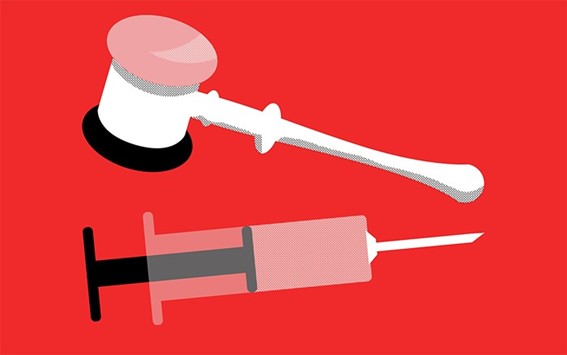By Bailey Ellicott

Death row is an environment designed to dehumanize and punish, and it does just that—these conditions are akin to solitary confinement, a severe punishment for inmates in general population restricted to limited periods of time.[1] For those sentenced to death, inmates live in these conditions for an average of over 14 years, but it is not uncommon to remain on death row for several decades.[2] Death row inmates typically spend 22 hours in a windowless cell each day.[3] They are isolated from other prisoners, excluded from prison educational and employment programs, and denied visitation and exercise.[4] They are fed through a small slot in the door and speak to guards through intercoms.[5] These conditions are so inhumane that some inmates have “volunteered” to die rather than continue to live in these conditions.[6]
These conditions would be cruel for anyone but have an especially profound impact on the mentally ill. In the United States, 4% of the population suffers from severe mental illness.[7] In correctional facilities, 10% of people suffer from severe mental illness.[8] The percentage of people on death row suffering severe mental illness is a staggering 20%.[9] Conditions of confinement often exacerbate mental health conditions. In 2007, a federal judge noted that putting prisoners with mental illness in these conditions is “the mental equivalent of putting an asthmatic in a place with little air.”[10] This statement is accurate. Of prisoners in isolation, 91% suffer from anxiety, 88% experience ruminations or intrusive thoughts, 86% noted hypersensitivity to stimuli, 84% had difficulty with concentration and memory, 71% suffer from severe mood and emotional swings, 61% report violent fantasies, 44% experience perceptual distortions, and 41% report hallucinations.[11] Furthermore, 34% of prisoners experience all eight of these conditions, and 56% experience at least five.[12]
Both an inmate’s physical and mental health start to disintegrate while in solitary confinement or on death row. Denis Hope, an inmate in Texas, was kept in isolation for over a decade after a prison escape in 1994.[13] He noted that conversations with his lawyers were the only thing keeping him sane, noting that his eyesight dimmed from the harsh lighting in his cell, his vocal cords weakened from not being used, and his vocabulary started to shrink.[14] Sensory deprivation sets in- an inmate on death row in Texas petitioned for a pastor to be able to place his hands on him during his scheduled lethal injection.[15] That inmate, John Henry Ramirez, noted that in over a decade spent on death row, he didn’t physically touch another person except during doctors’ appointments and brief moments when guards handcuffed him.[16] Mr. Ramirez won his Supreme Court case.[17] For him, this win meant he was killed by lethal injection on October 5, 2022 with his pastor’s hands on his chest.[18] Quintin Jones, in a tearful plea to Governor Abbott nine days before his execution, described the mental effects of living on death row for over 20 years, during which time he saw over 300 people executed in the Livingston, Texas prison.[19] Mr. Jones was killed on May 19, 2021.[20]
It is disturbingly easy for an incompetent person to end up convicted and on death row. Because of the relative ease in which a defendant may be deemed competent, a mentally ill person may both stand trial and be put to death.[21] There is a competency threshold to be executed- a person must have a rational understanding of the reason that the state wants him executed.[22] However, this standard is poorly defined and offers little protection to the mentally ill. Between 2000 and 2015, 43% of those executed suffered from severe mental illness.[23] In 2015 alone, 7 of 28 suffered from extreme mental illness, and another 7 suffered from serious intellectual impairment or brain injury.[24] That is half of those sentenced to death. The landmark case of Atkins v. Virginia held that it is a violation of the Eighth Amendment to execute a mentally disabled defendant.[25] In 2019, though, the Supreme Court held that a mental disorder leaving a prisoner with no memory of the crime he committed does not preclude execution.[26] In short, conditions of confinement work to break an individual down, and the law does not offer sufficient protection to prevent an execution. This leaves one question: is our prison system failing the most vulnerable, or is it working exactly as intended?
[1] Death Penalty Information Center (DPIC), Time On Death Row, https://deathpenaltyinfo.org/death-row/death-row-time-on-death-row (accessed Nov. 10, 2022).
[2] ACLU, A Death Before Dying: Solitary Confinement on Death Row 8 (2013), https://www.aclu.org/report/death-dying-solitary-confinement-death-row.
[3] Tiana Herring, The Research is Clear: Solitary Confinement Causes Long-Lasting Harm, Prison Policy Initiative, https://www.prisonpolicy.org/blog/2020/12/08/solitary_symposium/ (Dec. 8, 2020).
[4] DPIC, supra note 1.
[5] Corinna Lain, Madison and the Mentally Ill: The Death Penalty for the Weak, Not the Worst, 31 Regent L. Rev. 209, 225 (2019).
[6] ACLU, supra note 2.
[7] Lain, supra note 5 at 224.
[8] Lain, supra note 5 at 224
[9] Lain, supra note 5 at 224
[10] Madrid v. Gomez, 889 F.Supp. 1146, 1265 (N.D. Cal. 1995).
[11] Lain, supra note 5 at 226
[12] Lain, supra note 5 at 226
[13] Adam Liptak, 27 Years in Solitary Confinement, Then Another Plea for Help in Texas, N.Y. Times (Feb. 14, 2022); https://www.nytimes.com/2022/02/14/us/supreme-court-solitary-confinement.html
[14] Id.
[15] Ruth Graham, On Death Row in Texas, a Last Request: A Prayer and ‘Human Contact’, N.Y. Times (Aug. 30, 2021); https://www.nytimes.com/2021/08/30/us/on-death-row-in-texas-a-last-request-a-prayer-and-human-contact.html
[16] Id.
[17] Ramirez v. Collier, 142 S.Ct. 1264 (2022).
[18] Graham, supra note 15.
[19] Jonah M. Kessel et. al, Dear Gov. Abbott, Please Save My Life, N.Y. Times (May 10, 2021); https://www.nytimes.com/video/opinion/100000007745082/quintin-jones-texas-death-row-clemency.html
[20] Edgar Sandoval, Texas’ First Execution in Nearly a Year Had No Reporters Present, N.Y. Times (May 24, 2021), https://www.nytimes.com/2021/05/20/us/texas-execution-quintin-jones-reporter.html.
[21] Lain, supra note 5 at 228.
[22] Panetti v. Quarterman, 551 U.S. 930, 960 (2007).
[23] Lain, supra note 5 at 228
[24] Lain, supra note 5 at 228
[25] Atkins v. Va., 536 US 304, 321 (2002).
[26] Madison v. Al., 139 S. Ct. 718, 726-27 (2019).

